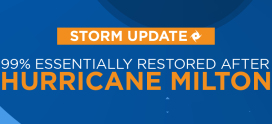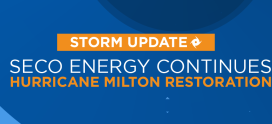
SECO Energy Restoring Power in the Wake of Hurricane Helene
Hurricane Helene made landfall in the Panhandle Thursday evening as a Category 4 storm, causing damage to SECO Energy’s electric system and leaving many members without power. SECO crews and mutual aid line and tree crews worked throughout the night to restore electric service to members’ homes.
As of 10 a.m. Friday morning, roughly 3,276 members are without electricity due to fallen wires, damaged poles, and severe flooding. Approximately 34,000 accounts have experienced service disruption from Helene, with 22,000 accounts at its peak.
Hundreds of workers from multiple states have lined up to assist SECO in power restoration. SECO Energy’s electric system sustained moderate damage that affected many of the communities SECO Energy serves. Crews continued the restoration process this morning.
“As we work to restore power in the aftermath of Hurricane Helene, I want to assure our members that SECO Energy is committed to getting the lights back on as quickly and safely as possible and will not stop until service has been restored to every member,” said Curtis Wynn, SECO Energy’s Chief Executive Officer.
Wynn continued, “Crews never stopped working overnight. They worked through rain and wind gusts that reached 70 mph in our northern areas; making significant progress in the restoration effort that continues this morning. We are thankful for their assistance and are thinking of our neighbors in north Florida whose homes and properties are severely damaged.”
SECO Energy urges members to stay safe in the wake of the storm, as conditions remain hazardous in many areas. Members are encouraged to follow the following safety tips:
- Stay away from downed wires. Always assume they are energized. Call 911 if you see a downed line.
- Avoid flooded areas. Flooding is a major threat from Hurricane Helene. Flash flooding can occur suddenly due to intense rainfall. Long-term flooding along rivers and streams can persist for days following a storm. When approaching water on a roadway, remember: Don’t Drown. Turn Around.
- Avoid crews working in the street. This will keep you and the crews safe and allow them to work on restoring your power.
- If you plan to use a portable generator, follow the manufacturer’s instructions and use only when necessary. Don’t overload it. Be sure to turn it off at night when you’re asleep or if you leave your home.
- To avoid the risk of carbon monoxide poisoning, place portable generators outside in a well-ventilated area, more than 20 feet away from your home, doors, and windows. Never run a generator inside, not even in your garage. Do not connect the generator directly into your home’s main fuse box or circuit panel.
- Protect food and refrigerated medicine with ice in an insulated cooler. If you are without power for more than two hours, refrigerated foods should be placed in a cooler. Foods will stay frozen for 36 to 48 hours in a fully loaded freezer if the door remains closed, and a half-full freezer will generally keep frozen foods for up to 24 hours. Check foodsafety.gov to learn more about when to throw out or keep food after a power outage.
- Tune in to local news broadcasts for the latest weather and emergency information.
For more storm safety tips, visit Ready.gov or download the American Red Cross’s Emergency Severe Weather App by texting “GETEMERGENCY” to 90999.




